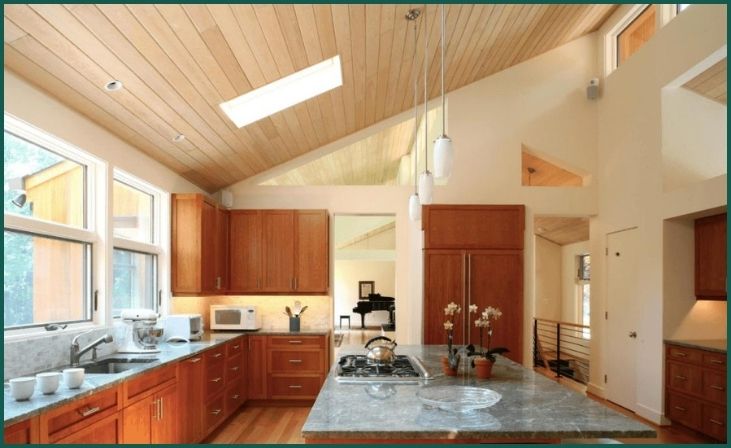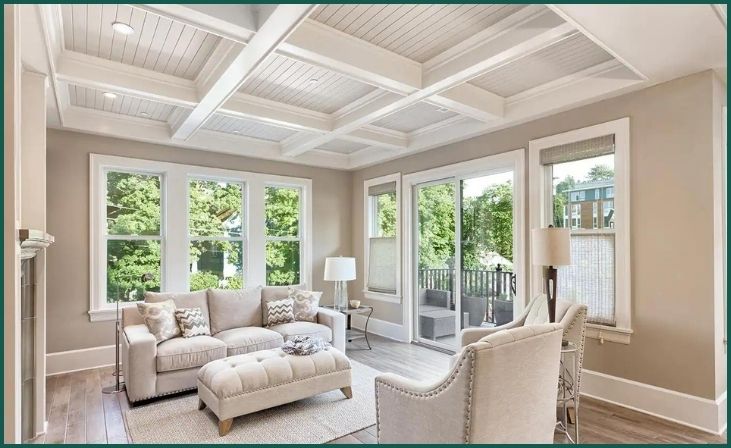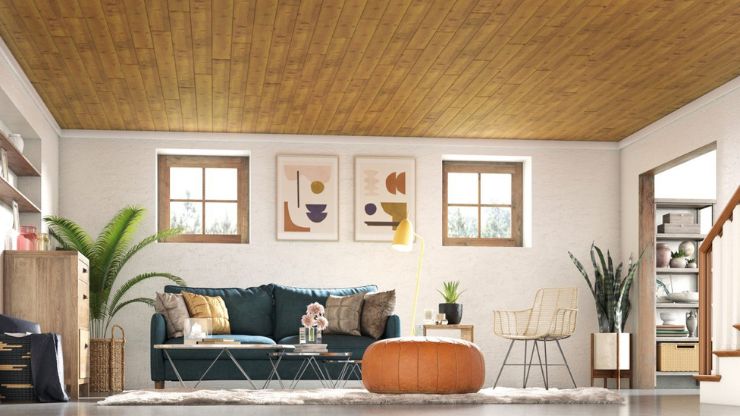When it comes to home renovation, ceilings often play a crucial yet overlooked role in shaping the overall look and feel of a space. From traditional designs to modern innovations, the ceiling type you choose can dramatically impact the style, functionality, and ambiance of a room. In this blog, we’ll delve into seven types of ceilings that every homeowner should know about before embarking on a renovation journey. Whether you’re aiming for a timeless classic appeal or a contemporary aesthetic, understanding these ceiling options will help you make informed decisions and transform your home into a visually stunning and comfortable sanctuary.
Table of Contents
ToggleTypes of Ceilings for Your Home Renovation
Suspended Ceiling

Also known as drop or dropped ceilings, this type is constructed by hanging a grid system below the existing ceiling and inserting tiles or panels into the grid. It is a practical choice for concealing electrical wiring, plumbing lines, ductwork, and other utilities while improving insulation and acoustics. Suspended ceilings offer easy access for maintenance, repairs, and renovations, making them popular in commercial spaces like offices, schools, and healthcare facilities. They are also commonly used in basements to create a finished and functional ceiling without major construction work. The variety of tiles available allows for customization in terms of color, texture, and acoustic properties, making suspended ceilings a versatile and cost-effective option for both residential and commercial applications.
Also Read- 8 Home Improvement Projects That Will Pay Off In 2024
Tray Ceiling
Tray ceilings, also known as recessed or inverted ceilings, feature a multi-level design that resembles a tray or a shallow inverted box. This type of ceiling adds depth and architectural interest to a room by creating steps or levels within the ceiling structure. Tray ceilings are typically installed in rooms with high ceilings, preferably at least 8 feet tall, to fully showcase their design elements. They are commonly found in bedrooms, dining rooms, and living rooms, where they add elegance and visual appeal. Lighting can be incorporated into the recessed areas of tray ceilings to create a dramatic effect and highlight the ceiling’s unique features.
Vaulted Ceiling

Vaulted ceilings are characterized by their upward-sloping design, which creates a sense of height, openness, and spaciousness in a room. They come in various styles, including cathedral ceilings with a steep inverted V-shape and domed vaulted ceilings with a central arch. Vaulted ceilings are often used in areas such as living rooms, dining rooms, and entryways to make a bold architectural statement. They are particularly beneficial in smaller spaces as they create the illusion of a larger room and allow for better natural light distribution. However, vaulted ceilings may require additional insulation and heating considerations due to their increased volume compared to standard ceilings.
Beam Ceiling
Beam ceilings, also known as exposed beam ceilings, feature exposed wooden beams that add character, warmth, and visual interest to a room. The beams can be decorative or structural, depending on the design and construction of the ceiling. Typically, the space between the beams is covered with finished drywall or other materials to create a cohesive look. Beam ceilings are popular in rustic, farmhouse, and contemporary-style homes, where they contribute to a cozy and inviting atmosphere. They are commonly found in living rooms, kitchens, and great rooms, where the exposed beams serve as a focal point and enhance the overall design aesthetic.
Don't just scroll, subscribe!
BuzzTrail's unique web-stories are the cure for boredom you've been waiting for.
Shed Ceiling

Shed ceilings, also referred to as single-slope ceilings, have a sloping design that starts high on one wall and gradually slopes down toward the opposite wall, creating a single-slope effect. This type of ceiling is commonly used in contemporary and minimalist designs to add architectural interest and visual appeal. Shed ceilings work well in rooms with unique layouts or irregular shapes, as they can adapt to different ceiling heights and angles. They create a dynamic and modern look, especially when combined with other design elements such as large windows, clean lines, and open floor plans. Shed ceilings are versatile and can be customized to suit various interior styles and preferences.
Coved Ceiling
Coved ceilings are created using curved molding or framing known as coves, which extend upward from the top of the wall to form a concave ceiling with curved edges. This type of ceiling adds a touch of elegance, sophistication, and architectural detail to a room. Coved ceilings are commonly found in theatres, churches, and formal areas of homes where a sense of grandeur and style is desired. They can be paired with decorative lighting fixtures or accentuated with paint or wallpaper to enhance their visual impact. Coved ceilings create a smooth transition between walls and ceilings, adding a unique and luxurious element to interior spaces.
Coffered Ceiling

Coffered ceilings are characterized by a grid of recessed panels separated by decorative molding, creating a patterned or grid-like appearance on the ceiling surface. This type of ceiling offers a classic and luxurious look reminiscent of traditional European architecture. Coffered ceilings are often found in libraries, hotels, and high-end homes where a sense of elegance and refinement is desired. They add depth, dimension, and visual interest to a room while creating a sense of architectural sophistication. However, coffered ceilings can be costly to install due to the intricate detailing involved, making them more common in upscale or custom-designed properties. They can be customized in terms of panel size, molding style, and finish to suit different design aesthetics and preferences.
For More- 8 Design Ideas for a Midcentury Modern Home
Conclusion
Understanding the different types of ceilings is crucial when planning a home renovation. Ceilings play a significant role in the overall look and feel of a space, impacting factors like light, space perception, and design aesthetics. Whether you opt for standard ceilings, vaulted ceilings, coffered ceilings, or other styles, each type brings its unique charm and character to a room. By choosing the right ceiling type, you can enhance the visual appeal and functionality of your living spaces, creating a home that reflects your style and meets your needs.
FAQs
How does ceiling height affect space in a room design?
How does ceiling height affect space in a room design?
High ceilings create a perception of more space, allowing for better ventilation, natural light, and room for decorations.
Can you change the height of the ceiling?
Can you change the height of the ceiling?
Homes with rafters can have their ceilings raised, but it requires strong structural support and expertise from an engineer.

